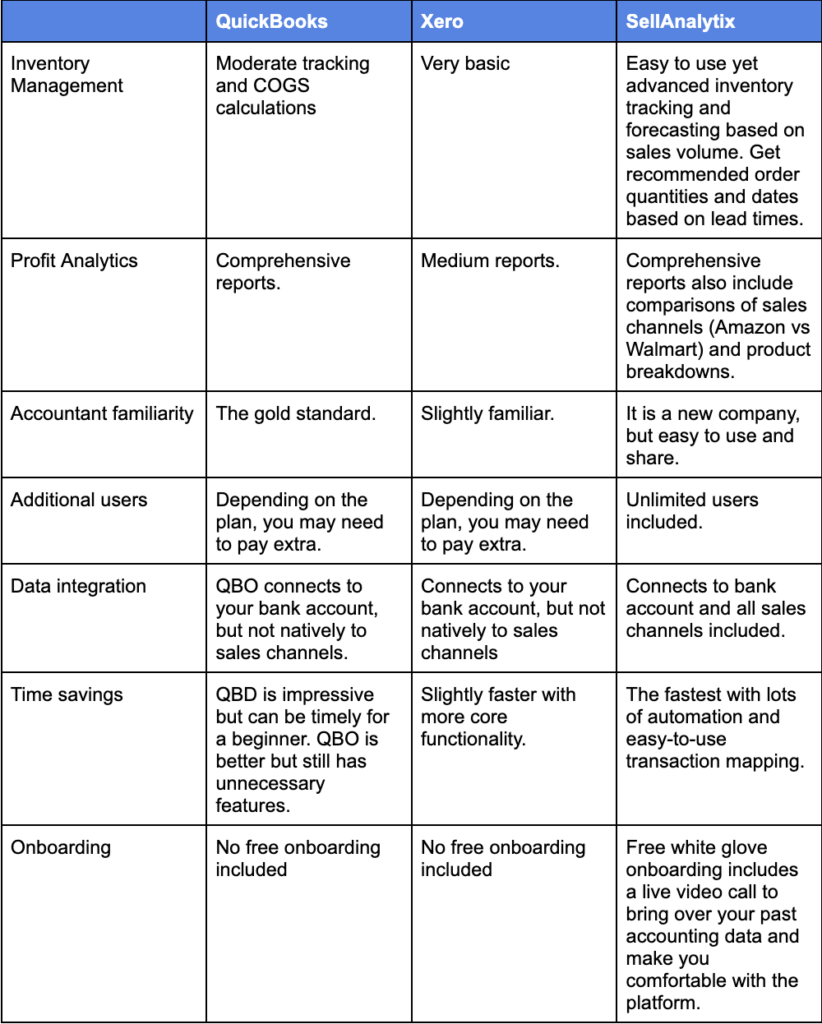Efficient accounting is crucial for e-commerce sellers to track profits, manage inventory, and stay on top of financial health. In this blog, we’ll explore three popular accounting solutions for e-commerce businesses centered around selling on Amazon: QuickBooks, Xero, and SellAnalytix. We’ll compare their key features and benefits, and why SellAnalytix emerges as the top choice for e-commerce sellers.
Overview of QuickBooks
QuickBooks is a widely known accounting software that offers several features for e-commerce sellers. If you go to any accountant, there is a strong chance they not only have heard of it but are using it as their primary accounting software.
They have two main plans with additional variations: QuickBooks Desktop (QBD), and QuickBooks Online (QBO).
QuickBooks Desktop is the older version and has more features relating to assets and inventory management than QBO. Its user interface is a bit outdated, and it has many features most e-commerce sellers don’t need but is more than capable of doing your accounting through purchase orders, invoices, journal entries, and payments. QBD does not have great syncing capabilities to Amazon, and either requires you to manually enter sales data, or pay for an expensive program like WebGility to sync data for you. However, it is the gold standard for what a CPA would be looking for.
QuickBooks Online is the newer subscription version of QuickBooks which is an online web app and mobile application. Its base plans do not include inventory so you need to pay extra to include the cost of goods sold in your reports. Being online, they do have an expansive app store that provides for various additional programs you can pay to connect to your various e-commerce channels like Shopify, Etsy, Walmart, and more. A2X is one of the most popular and usually costs a bit over $19/ month extra. QBO is another program most accountants are very familiar with.
Overview of Xero
Xero is another reputable accounting solution often favored by businesses of smaller sizes. It offers robust accounting capabilities and supports integrations with various third-party apps, including some e-commerce platforms. It is able to connect to your bank account and do basic accounting transitions, but its inventory management is very limited in functionality. You can only see inventory at one location, and it’s not intuitive how to map transactions to your COGS for accurate accrual accounting. It is cheaper than QBD & QBO, and somewhat familiar to accountants, but lacks many of the features e-commerce sellers require being an inventory-heavy business.
Introducing SellAnalytix
SellAnalytix is a full-fledged accounting software designed specifically for e-commerce sellers. It connects to all your sales channels like Amazon natively, syncing all your orders and financial data as well as connecting to your bank account. Once set up, you are able to do all your monthly accounting in under 8 minutes per month. QBD might be the gold standard for accountants, but its complex accounting jargon and confusing menus can scare off new sellers. Additionally, because it connects to your channels you can see various related metrics updated every hour to see how your profitability, advertising, and other metrics are tracking.
Comparison of Key Features
Let’s take a closer look at how these three tools compare in key areas for e-commerce sellers:

Pricing Comparison
QuickBooks Online: they have multiple plans, but sellers require inventory which is $85 per month. A2X to sync starts at $19 per month to connect to sales channels.
QuickBooks Desktop: Starting at $500 per year, Intuit is trying to phase out this program and switch users to QBO.
Xero: cheaper than QuickBooks, and is $37 per month for the middle plan that includes what e-commerce sellers need.
SellAnalytix: Starting at $27 for up to 500 orders or $67 for up to 3,000 monthly orders, this plan is in the middle, but includes more functionality than both.
Customer Support and User Experience
Despite Intuit being a multinational employee company, getting a hold of a real person is a challenge and may come with extra support fees.
Xero has better online documentation, but being smaller doesn’t have as many support agents to help. However, once you get hold of someone, they are generally quite knowledgeable and helpful.
SellAnalytix is a smaller company, but excellent customer service is a core value. You can speak directly to an American agent within minutes during business hours and get the help you need.
Conclusion
In the realm of e-commerce accounting tools, QuickBooks and Xero are solid choices for general accounting needs. However, for e-commerce sellers seeking a specialized and comprehensive solution, SellAnalytix emerges as the ultimate winner. With its tailored features, real-time insights, and user-friendly experience, SellAnalytix empowers sellers to take control of their finances and achieve sustainable growth. Try SellAnalytix for free today and witness the difference it can make for your e-commerce business!
